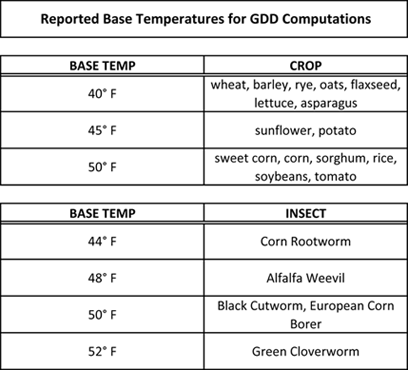Advanced Menu Options
What is a Growing Degree Day?
From Farmwest.com:
"Growing degree days (GDD) is a weather-based indicator for assessing crop development.
It is a calculation used by crop producers that is a measure of heat accumulation used to
predict plant and pest development rates such as the date that a crop reaches maturity."
"Growing degrees (GDs) is defined as the mean daily temperature (average of daily maximum
and minimum temperatures) above a certain threshold base temperature accumulated on a daily
basis over a period of time. Negative values are treated as zeros and ignored. The base
temperature varies among crops and the value is derived from the growth habits of each
specific crop. The base temperature is that temperature below which plant growth is zero."
GDD Calculation:
GDD = [(Tmax + Tmin) / 2.] - Tbase
Station Selection
Select a station from the drop-down menu at the top. The graphic will automatically
update with that station's GDD data, for the beginning of the year to the current date, using
a default base temperature value of 50°F.
The list of stations included are long-term, high quality, National Weather Service COOP
stations with at least 50 years of data.
Graphic Information
Graphics are generated by Highcharts.com.
Click and drag mouse across graphing area to zoom in on specific dates.
Menu at top right of graphic gives options to save graphic as an image.
Advanced Menu Options
Select your own start date and end date, with the option to view previous years.
Accumulating values will begin at zero on the start
date, even if the growing season started prior to your start date.
You can also select a different base temperature. From the Midwestern Regional Climate Center, some common base temperatures are:
